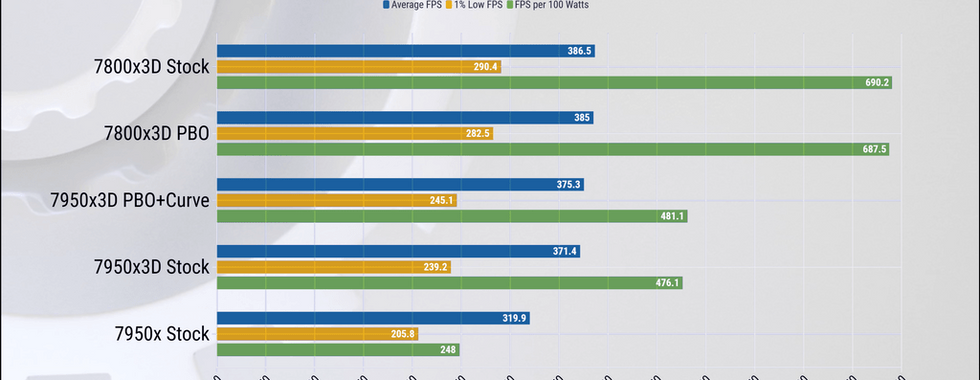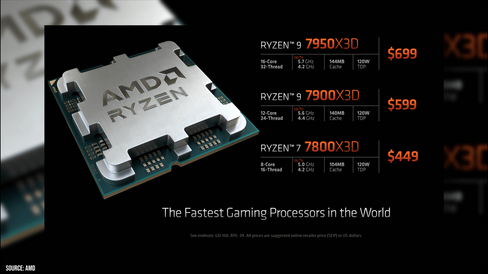Unleashing the Power: AMD Ryzen 7800 X3D with A620 Motherboard Creates an Affordable Gaming Beast
- A2K
- Nov 27, 2023
- 6 min read
Updated: Nov 2
Just recently AMD took the crown of the best gaming CPU with the 7950x3D but that was at a serious premium. Also it is not exactly a gaming focused chip rather something that can do gaming, streaming and bunch of other things due to its core count. Well, now we have the 8 core 7800x3D chip which is both - much cheaper and actually much better for gamers, let’s get into it!
Rather than covering details about these X3D chips, we will flip the script and go into the results first and if you are interested - at the end of the video I will share my opinion and an unexpected setup for those who want to save some money. Feel free to use chapters to jump around. For our testbench we are using x670e motherboard, 6000 M/T RAM and RTX 4090 FE to ensure we are not bottlenecked, which with this CPU is actually very possible even with the 4090. We will compare these chips to the recently reviewed Ryzen 9 7950x3D.

Let's begin with gaming and the classic favourite, Shadow of The Tomb Raider, at 1080p resolution. It's important to note that we've opted for lower graphical settings to achieve higher frame rates, which still leads for the GPU to get really close to max load and risk of becoming the bottleneck.
In this test, the 7800X 3D shows a slight improvement in average FPS compared to the Ryzen 9, with identical 1 percentiles, but a considerably better performance per Watt. We observe a 39-43% improvement in this aspect. When compared to the older 7950x, the 7800X 3D offers a 30% higher frame rate while being almost 3 times more power efficient.
Moving on to 1440p, we see a similar trend, with around a 6% performance improvement in average FPS at stock settings and a 45% enhancement in efficiency.
At 4K resolution, the results remain fairly consistent. There is a 4% improvement in 1 percentiles and a 45% increase in power efficiency.
Moving on to the next game, Horizon Zero Dawn, which places a heavier demand on the GPU, with this we notice lower frame rates. Despite it, at 1080p, the new CPU still outperforms the 7950x 3D by 10% in average FPS and around 4% in 1 percentiles. Additionally, there's still an impressive 44% improvement in FPS per Watt.
At 1440p, the performance continues to be approximately 10% faster in average FPS, with virtually the same 1 percentile results.
When it comes to 4K, all of these examples display nearly identical frame rates, mainly due to the previously mentioned GPU bottleneck. While this result may not be the most useful for CPU testing, as other variables aside from the CPU can influence the outcome, it's crucial to highlight that even with the GPU bottleneck, the 7800x 3D chip still shows significantly higher power efficiency. At stock settings, we see a roughly 34% improvement, and with PBO enabled, this increases to about 37%.
The next game we tested was World War Z Aftermath, which is quite the opposite of Horizon Zero Dawn in terms of performance requirements. It is significantly easier to run, and as a result, any differences in performance become more pronounced. At 1080p, we observed nearly 30% higher average FPS and 1 percentiles, along with a remarkable 65% improvement in power efficiency.
The FPS per 100 Watts graph for this game appears almost absurd, but it is what it is. At 1440p resolution, we see a similar trend - a 26% improvement over the 7950x 3D in average FPS and 31% in 1 percentile performance, while maintaining a 64% higher FPS per Watt.
Lastly, at 4K, we noted a 17% increase in average FPS, a 26% improvement in 1 percentiles, with 50% better power efficiency.
While we could continue with more examples, the main point of interest is the performance delta. AMD's briefing mentioned that the performance should be quite similar, and in some cases, worse. However, that's not what we're observing here, which raises the question - what happened?
There are a few possibilities to consider. One explanation could be the silicon lottery, where the 7950x 3D chip we tested was not reaching its full potential, while the 7800x 3D simply excels. Another potential issue could be the chipset driver, and more importantly, the scheduling tool that we had to use on the dual CCD design, which might have caused performance loss. By the way, if you haven't seen our previous video for the 7950x 3D, the link is in the description below.
We will try to dig deeper, and if there's anything noteworthy, we'll make a video about it. Make sure to subscribe so you don't miss it.
With that said, let's move on to some productivity benchmarks, as well as a deeper investigation into power and thermals, starting with V-Ray. In this test, with half the cores, the 7800x 3D has half the performance of the 7950x 3D. Enabling PBO provides a small boost, but just like in gaming, it's not substantial.
One area where high core count is not as crucial is video editing, as clearly demonstrated with the Davinci benchmark by Puget Bench. While the 7950x 3D is faster here, the difference is about 10%, which is not a deal-breaker. If you're working with a limited budget, it's recommended to invest more in the graphics card, as it can handle many workloads, allowing your CPU to keep performing well.
On the other hand, if you're someone who deals with more CPU-intensive workloads requiring many cores, this chip might not be the best choice. Take, for instance, the difference in CPU Blender render times. The higher-end chip, with more cores, completes the render in nearly half the time.
This leads us well to the next point: during these tests, we also tracked thermals and power consumption. Like the rest of the 7000 series chips, AMD designed them to push hard, resulting in high temperatures. We managed to cool the chip to about 77 degrees Celsius with a 360mm liquid AIO while running at 100% speed. This is with 28 degree ambient temperature.
With PBO and Curve Optimizer enabled, the chip maintained a 4.9 GHz speed throughout the whole test, which is quite impressive. Without the Curve Optimizer, it reached 4.75 GHz, suggesting it was power-limited.
Power consumption analysis supports this theory, as the 7800x 3D consistently hovers around the 80-watt mark with all three configurations. Throughout our testing, it never exceeded 84 watts and in gaming reached 70 watts at most during the 1440p test in Shadow of The Tomb Raider. And this is for a good reason.
The unique architecture of the AMD Ryzen 7800X3D chip builds upon the previous generation by expanding the Level 3 cache through the addition of memory directly atop the die, earning it the 3D designation. This technique was previously implemented in the 8-core 5800X3D chip with a single CCD. However, due to power limitations, these chips operate at reduced voltage, resulting in lower frequencies compared to non-3D counterparts, and manual overclocking is not available.
AMD employs the same methodology in this latest generation, incorporating Ryzen 7000's IPC improvements and an additional Curve Optimizer for voltage target tweaking. With some silicon luck, you might squeeze slightly more performance from these chips.
Arguably, the best feature of this CPU is the lack of overclocking, which may seem counterintuitive, but the CPU performs well out of the box. It doesn't require motherboards with numerous VRM phases and robust power delivery, allowing for budget-friendly PC builds with a low-end A620 motherboard. Some boards are priced as low as 100 USD, which, when paired with this CPU, creates a powerful system without unnecessary extras. However, be careful when choosing A620 motherboards, as some low-end options only support 65W chips. Opt for ones that support 120W.
In conclusion, the new 7800x 3D is an impressively fast and efficient chip, which will likely impact both Intel's sales and those of higher-end AMD processors, hence the delayed release strategy.
Until now, opting for a 7000 series chip came with a premium due to the absence of affordable motherboards and the high cost of DDR5 memory. The performance increase didn't always justify the expenditure. However, this situation is changing. With the introduction of the 7800x 3D and mid-range A620 boards, the market is poised for a shake-up, offering gamers fantastic value for their money.
We'd love to hear your thoughts on this launch, and whether you're considering picking up one of these chips. Let us know in the comments below!




























































Comments